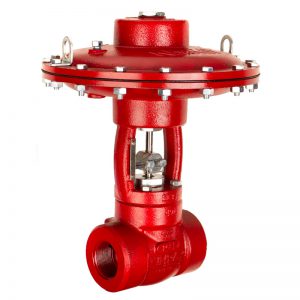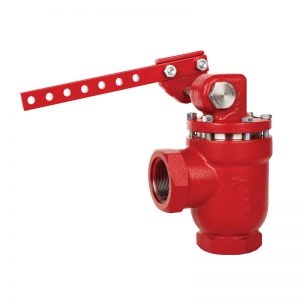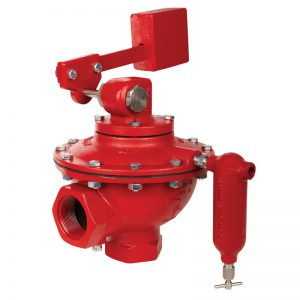
A liquid control valve regulates the flow of liquid. There are many varieties of liquid control valve. In this article, we’ll cover three common types: a High Pressure Control Valve, a Weight-Operated Dump Valve, and a Liquid Dump Valve.

High Pressure Control Valve
A High Pressure Control Valve is a highly versatile product that can be used in both liquid and gas control applications. Example applications include liquid dump (liquid) and back pressure regulation (gas).
This valve remains in its fail position (open or closed) until told to do otherwise by a pilot.
In a liquid dump application, it will receive a pneumatic signal from a liquid level controller to open and dump the liquid.
The flow through the stem-guided high pressure control valve comes from on top of the seat. This type of valve offers precise control with the small Cv trim options.
The Kimray High Pressure Control Valve can also be field converted to fail open or close with simple hand tools.

Liquid Dump Valve
Another common type of liquid control valve is the Liquid Dump Valve.
A Liquid Dump Valve is a component of a liquid level control system used to maintain and control the liquid level in production vessels.
A mechanical liquid level control system is made up of five primary parts: Trunnion Assembly, Float Arm, Float, Linkage Rod, and Liquid Dump Valve.
A dump valve is connected to downstream piping. When the float rises to the desired level, the linkage rod rises, lifting the arm on the dump valve. This opens the valve and “dumps” the liquid from the vessel downstream to be further processed or sold.

Weight-Operated Dump Valve
A Weight-Operated Dump Valve can also be classified as a liquid control valve.
The Kimray Weight-Operated Dump Valve is a weight-operated throttling valve that holds liquid level in production vessels such as heater treaters, free water knockouts, and saltwater disposal systems.
The Weight-Operated Dump Valve actuates based on the pressure generated from the column of liquid in the discharge piping from a vessel.
A weight and lever hold the seat closed by pushing down on the diaphragm assembly. When the liquid rises above the set level, it overcomes the force of the weight. This lifts the diaphragm assembly against the weight load to open the valve.
As liquid is discharged and the column of liquid lowers, the weight closes the valve.








































